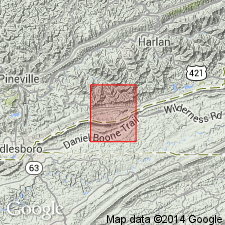
- Usage in publication:
-
- White Rocks Sandstone Member*
- Modifications:
-
- Mapped
- Dominant lithology:
-
- Sandstone
- AAPG geologic province:
-
- Appalachian basin
Summary:
White Rocks Sandstone Member of Lee Formation. A fine- to coarse-grained, very light-gray, quartzose, massive, cross-bedded sandstone with well-rounded quartz pebbles ranging from 0.5 to 1 inch in diameter. Includes in middle a lentil of very fine-grained, wavy-bedded, light-olive-gray sandstone. Thickness 125 to 340 feet. Occurs near base of Lee Formation. Overlies sandstone member A; underlies sandstone member B (both of Lee). Age is Pennsylvanian.
Source: GNU records (USGS DDS-6; Reston GNULEX).
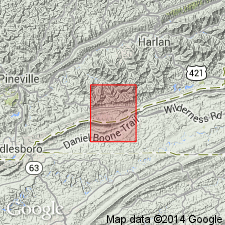
- Usage in publication:
-
- White Rocks Sandstone Member*
- Modifications:
-
- Principal reference
- Dominant lithology:
-
- Sandstone
- AAPG geologic province:
-
- Appalachian basin
Summary:
Pg. B13, pl. 1. White Rocks Sandstone Member of Lee Formation. Formal proposal of name. Cliff-forming unit along Tennessee Valley Divide, capping Cumberland Mountain east of White Rocks and forming sheer-sided hogbacks on north slope west of White Rocks. Consists of conglomeratic, very light-gray, fine- to coarse-grained, quartzose sandstone. Locally, member contains 75 percent or more of well-rounded quartz pebbles ranging from 0.5 to 1 inch in diameter. Pebbles are most abundant near base of member. In Ewing quadrangle, is most conglomeratic member of formation. Thickness 300 feet at type exposure; 125 feet on west edge of Ewing quadrangle; 340 feet on east edge. Overlies sandstone member A of Lee Formation with sharp, undulatory, scour-type contact; gradationally underlies sandstone member B of Lee Formation. Age is Pennsylvanian.
Named from exposures at White Rocks, a prominent south-facing cliff at crest of Cumberland Mountain, Ewing 7.5-min quadrangle, Harlan Co., southeastern KY; overlooks town of Ewing, in Lee Co., southwestern VA. Caps Cumberland Mountain and forms sheer-sided hogbacks on north slope west of White Rocks.
Source: US geologic names lexicon (USGS Bull. 1350, p. 826); GNU records (USGS DDS-6; Reston GNULEX).
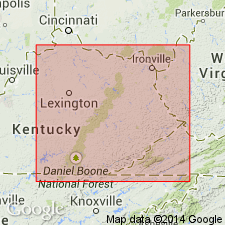
- Usage in publication:
-
- White Rocks Sandstone Member*
- Modifications:
-
- Age modified
- AAPG geologic province:
-
- Appalachian basin
Summary:
Age of White Rocks Sandstone Member of Lee Formation changed from Early Pennsylvanian to Late Mississippian because it intertongues with marine reddish or greenish shale of Pennington Formation, or with equivalent strata, that contains a Late Mississippian fauna.
Source: GNU records (USGS DDS-6; Reston GNULEX).
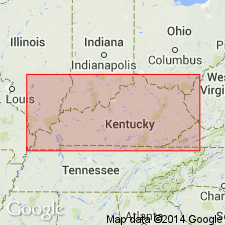
- Usage in publication:
-
- White Rocks sandstone bed
- Modifications:
-
- Revised
- AAPG geologic province:
-
- Appalachian basin
Summary:
Pg. 9-11, figs. 6-7. White Rocks sandstone bed (informal) of Warren Point Sandstone of Breathitt Group. [Reinterprets Englund and DeLaney's 1966 (USGS Prof. Paper 550-D, fig. 2) classification of the Lee Formation along Virginia-Kentucky State line (Lee Co., VA, and Bell and Harlan Cos., KY).] (†Lee Formation dropped from Kentucky nomenclature.)
Source: Publication.
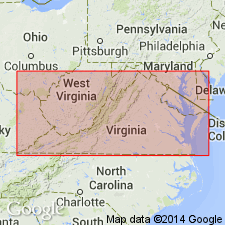
- Usage in publication:
-
- White Rocks Sandstone Member
- Modifications:
-
- Areal extent
- AAPG geologic province:
-
- Appalachian basin
Summary:
White Rocks Sandstone Member of Lee Formation crops out along Cumberland Mountain between Butcher Knob and Pennington Gap, VA. The member has a maximum thickness of 340 ft in the Ewing quad. and thins both northeastward and southwestward. The sandstone is quartzose, fine to coarse grained and has conglomeratic lenses containing well-rounded quartz pebbles up to 1 in. in diameter. May also include an olive-gray, very fine grained, wavy-bedded sandstone lens 0 to 50 ft thick. Member generally grades laterally and upwards into the Dark Ridge Member. Near Big Stone Gap, it grades laterally into grayish-red and greenish-gray siltstones of the Bluestone formation and into medium- to dark-gray siltstones of the Pocahontas Formation. Age of the White Rocks and the two underlying members of the Lee is Late Mississippian (Chesterian).
Source: GNU records (USGS DDS-6; Reston GNULEX).
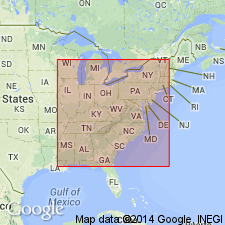
- Usage in publication:
-
- White Rocks Sandstone Member*
- Modifications:
-
- Age modified
- AAPG geologic province:
-
- Appalachian basin
Summary:
White Rocks Sandstone Member is Early Pennsylvanian following usage of Englund and others (1985, U.S. Geological Survey Open-File Report 85-577).
Source: GNU records (USGS DDS-6; Reston GNULEX).
For more information, please contact Nancy Stamm, Geologic Names Committee Secretary.
Asterisk (*) indicates published by U.S. Geological Survey authors.
"No current usage" (†) implies that a name has been abandoned or has fallen into disuse. Former usage and, if known, replacement name given in parentheses ( ).
Slash (/) indicates name conflicts with nomenclatural guidelines (CSN, 1933; ACSN, 1961, 1970; NACSN, 1983, 2005, 2021). May be explained within brackets ([ ]).

